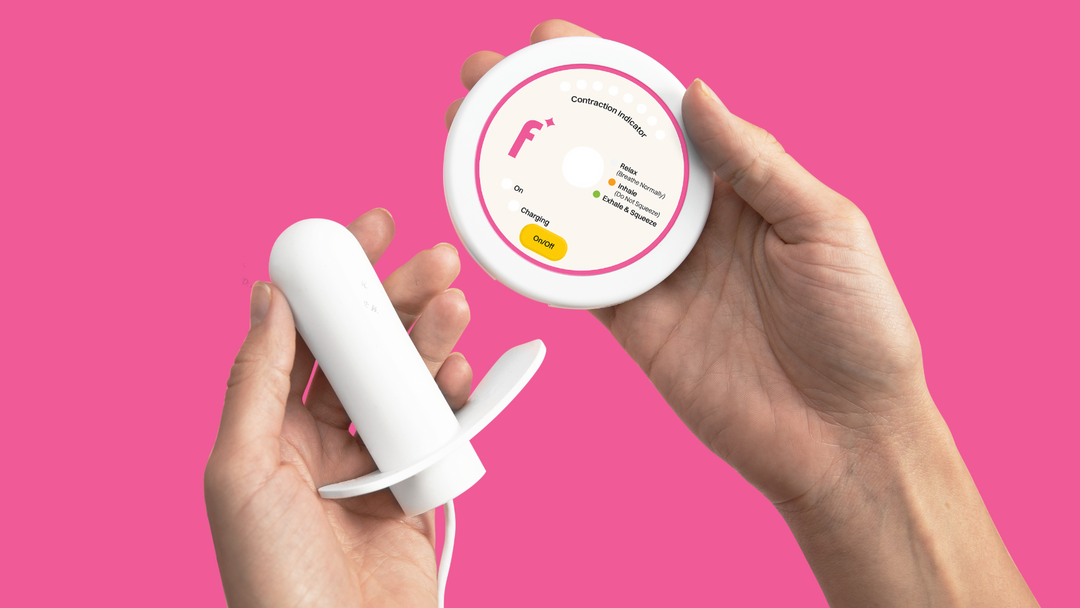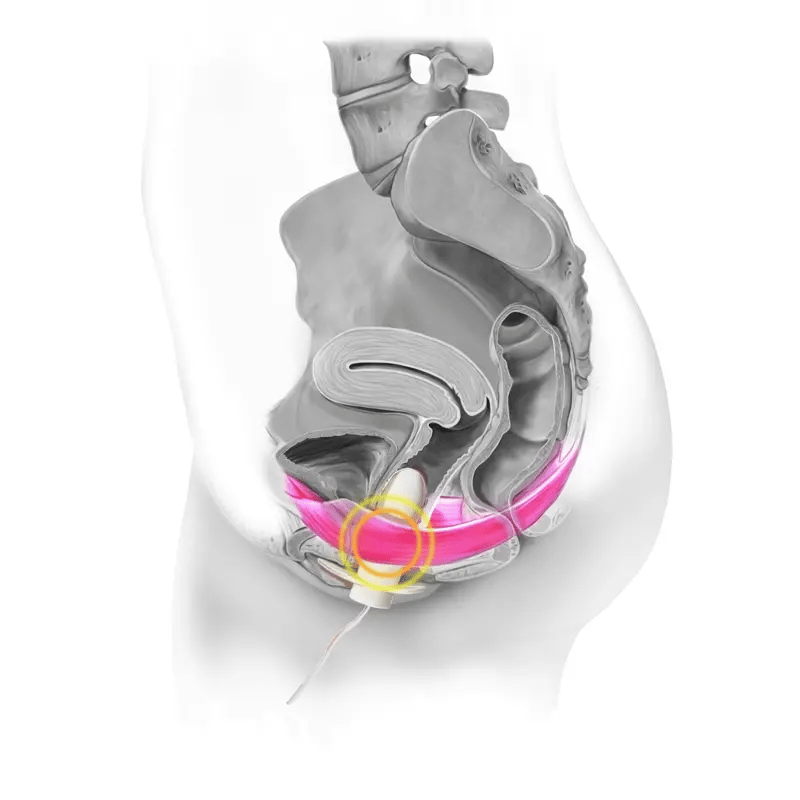Mechanotherapy treatment and the pelvic floor
When applied to the pelvic floor, mechanotherapy stimulates cellular-level changes in the pelvic floor muscles, leading to long-lasting improvements in muscle tone, strength, and neuromuscular memory.

What is Mechanotherapy?
Mechanotransduction is the biological process under which cells respond to mechanical stimuli, leading to changes in muscle strength, tone, and muscular memory.⁵⁻⁸ The benefits of mechanical stimulation include improved alignment of regenerating myotubes, faster and more complete regeneration, and minimization of atrophy of surrounding myotubes.⁷ Mechanotransduction is an ongoing physiological process in the human body, just like respiration and circulation. It plays a crucial role in underpinning musculoskeletal rehabilitation specific to the repair or remodeling of injured tissue.⁵،⁷
Mechanotherapy is the clinical triggering of mechanotransduction for tissue repair and rehabilitation.
Mechanotherapy is shown in the literature to have a cellular level impact and a neuromuscular impact.¹
Cellular impact of mechanotherapy
Mechanical stimulation deforms the cytoskeleton of the cell, causing micro tissue damage. The cell responds reflexively – in the process of mechanotransduction – with tissue repair, by recruiting additional filaments and stem cells.¹ The strengthening of pelvic floor muscle tissue caused by cellular repair is key to achieving initial continence.
Neuromuscular impact of mechanotherapy
When delivered in the form of vibration in certain frequency ranges, mechanotherapy stimulates mechanoreceptors in muscles that activate the tonic vibration reflex (TVR).¹ TVR in turn activates the proprioceptive nervous system, leading to improved neuromuscular facilitation, motor learning & muscle memory.¹ This is key to long-tern durability of results.

Flyte’s delivery of mechanotherapy
Flyte’s wand is designed in size, shape, and resistiveness to provide optimal contact within the vaginal canal and to deliver a gentle pre-stretch to the pelvic floor muscles. This is because research shows that applying mechanical stimuli to tensioned tissue elicits a stronger cellular response.¹
The Flyte wand then delivers mechanotherapy in the form of gentle, low-frequency vibration at a specific frequency. Flyte superimposes this mechanotherapy over guided contractions and relaxations of the pelvic floor.
A deeper dive into the science
Pelvic floor muscles are skeletal muscles attached to bones by tendons, controlled by a division of the nervous system, that produce movements as part of a mechanical system. This is achieved by altering the length and contraction velocity of the muscle fibers. Pelvic floor muscle strengthening involves consistent repetition of voluntary contractions and relaxations of the pelvic floor muscles through a range of motion. Gains in muscle strength and resting muscle tone occur with repeated challenges provided by resistance that leads to microdamage of the muscle fibers.
Similarly, applying mechanical stimulus to muscle cells causes microdamage to the cytoskeleton of the cells. This microdamage triggers the body’s natural repair process, which involves recruiting additional muscle fibers.⁵ Adding a mechanical stimulus (mechanotherapy) during a muscle contraction further increases muscle fiber recruitment. As moremuscle fibers are recruited, the muscle’s contraction force grows stronger.⁹
When mechanical stimuli, one form of which is vibration in a specific frequency range, are superimposed on skeletal muscle, musculoskeletal changes result, and the body reflexively responds by increasing muscle fiber recruitment to increase muscle strength and resting tone.⁵،⁷،⁹ Research has shown that the application of mechanical stimulation in the form of vibration to pre-stretched tissues as well as on contracted tissues, amplifies the results of strength and tone along with a stronger muscle reflex.⁹
In addition to cellular-level changes in muscle tissue, mechanotherapy modulates or normalizes nerve signaling via the stimulation of
mechanoreceptors in muscles which activate the proprioceptive sensory system.¹⁰ This enhances afferent and efferent neural communication with the reflexive spinal sacral plexus pathways as well as the higher conscious control centers of the brain.¹¹⁻¹² The cumulative effect of improved neuromuscular facilitation and motor learning manifests in the development and retention of muscle memory.¹³⁻¹⁴ Non-intravaginal whole-body vibration, a form of mechanotherapy, is an indirect treatment approach which has been shown in several studies to provide significant improvements in urinary incontinence.¹⁵⁻¹⁹
Transvaginal mechanotherapy
Transvaginal mechanotherapy treatment, a direct treatment approach via an intravaginal device as delivered by Flyte, is a targeted approach for treating urinary incontinence that improves both objective outcomes and subjective quality of life while avoiding the risks associated with surgery.²،⁴ A recent review article on mechanotherapy¹ concluded that:
- Mechanotherapy promotes muscular, cellular, and neuromuscular rehabilitation.
- Transvaginal mechanotherapy for female SUI results in superior pad weight reduction and superior quality of life improvements compared to traditional pelvic floor muscle training.
- Continence and durability outcomes of transvaginal mechanotherapy were comparable to surgery.
- Transvaginal mechanotherapy is a first-line, accessible treatment and should be part of the standard of care for stress urinary incontinence when pelvic floor muscle training is indicated.
- Transvaginal mechanotherapy increases access to clinically effective, first-line conservative treatment for women with urinary incontinence by allowing at-home participation to reduce barriers to conservative care.
- The use of transvaginal mechanotherapy superimposed on pelvic floor muscle training increases the efficacy of an already widely accepted conservative gold standard SUI treatment, allowing patients to achieve both their short and long-term continence goals with greater efficacy and a shorter treatment time.
- Incorporating transvaginal mechanotherapy in the treatment of female SUI appears to improve both objective outcomes and subjective quality of life, while avoiding the risks associated with surgery.¹
Transvaginal mechanotherapy, and the delivery of transvaginal mechanotherapy by the Flyte System, was added summer 2024 to the Modalities and Pelvic Function course and core series by the Herman & Wallace Pelvic Rehabilitation Institute, a leading provider of certification and continuing education for pelvic floor physical therapists.
References
1. Fulker A, Kovela S, Mianulli M. Transvaginal mechanotherapy for stress urinary incontinence: Principles, cellular and neuromuscular mechanisms of action, and comparison to current gold standard treatments. Continence Reports. 2025 Mar;13C. 100077. doi: https://doi.org/10.1016/j.contre.2024.100077.
2. Nilsen I, Rebolledo G, Acharya G, Leivseth G. Mechanical oscillations superimposed on the pelvic floor muscles during Kegel exercises reduce urine leakage in women suffering from stress urinary incontinence: A prospective cohort study with a 2-year follow up. Acta Obstet Gynecol Scand. 2018 Oct;97(10):1185-1191. doi: 10.1111/aogs.13412. Epub 2018 Aug 2. PMID: 29923602
3. Data on file at Pelvital.
4. Nakib N, Sutherland S, Hallman K, Mianulli M, R Boulware D. Randomized trial of mechanotherapy for the treatment of stress urinary incontinence in women. Ther Adv Urol. 2024 Feb 6;16:17562872241228023. doi: 10.1177/17562872241228023. PMID: 38328552; PMCID: PMC10848796.
5. Dunn SL, et al. Mechanotransduction: Relevance to Physical Therapist Practice - Understanding Our Ability to Affect Genetic Expression Through Mechanical Forces. Phys Ther, 96 (5):712-721, 2016.
6. Asavasopon S, Rana M, Kirages DJ, Yani MS, Fisher BE, Hwang DH, Lohman EB, Berk LS, Kutch JJ. Cortical activation associated with muscle synergies of the human male pelvic floor. J Neurosci. 2014 Oct 8;34(41):13811-8. doi: 10.1523/JNEUROSCI.2073-14.2014. PMID: 25297107; PMCID: PMC4188976.)
7. Khan KM, Scott A. Mechanotherapy: how physical therapists' prescription of exercise promotes tissue repair. Br J Sports Med. 2009 Apr;43(4):247-52. doi: 10.1136/bjsm.2008.054239. Epub 2009 Feb 24. PMID: 19244270; PMCID: PMC2662433.
8. Huang C, Holfeld J, Schaden W, Orgill D, Ogawa R. Mechanotherapy: revisiting physical therapy and recruiting mechanobiology for a new era in medicine. Trends Mol Med. 2013 Sep;19(9):555-64. doi: 10.1016/j.molmed.2013.05.005. Epub 2013 Jun 18. PMID: 23790684
9. Poenaru D, Cinteza D, Petrusca I, Liliana CI, Dumitrascu D. Local application of vibration in motor rehabilitation–scientific and practical considerations. Maedica. 2016 Sep;11(3):227.
10. Roudaut Y, Lonigro A, Coste B, Hao J, Delmas P, Crest M. Touch sense: functional organization and molecular determinants of mechanosensitive receptors. Channels (Austin). 2012 Jul-Aug;6(4):234-45. doi: 10.4161/chan.22213. PMID: 23146937; PMCID: PMC3508902.
11. Birder L, Drake M, De Groat WC, Fowler C, Mayer E, Morrison J, Paton J, Griffiths D, Mills I, Thor K. Neural control. Incontinence. 2009;4:167-254. https://www.ics.org/publications/ici_4/files-book/comite-3.pdf.
12. de Groat WC, Yoshimura N. Afferent nerve regulation of bladder function in health and disease. Handb Exp Pharmacol. 2009;(194):91-138. doi: 10.1007/978-3-540-79090-7_4. PMID: 19655106; PMCID: PMC3383010.
13. Sønksen J, Ohl DA, Bonde B, Laessøe L, McGuire EJ. Transcutaneous mechanical nerve stimulation using perineal vibration: a novel method for the treatment of female stress urinary incontinence. J Urol. 2007 Nov;178(5):2025-8. doi: 10.1016/j.juro.2007.07.012. Epub 2007 Sep 17. PMID: 17869299.
14. Asavasopon S, Rana M, Kirages DJ, Yani MS, Fisher BE, Hwang DH, Lohman EB, Berk LS, Kutch JJ. Cortical activation associated with muscle synergies of the human male pelvic floor. J Neurosci. 2014 Oct 8;34(41):13811-8. doi: 10.1523/JNEUROSCI.2073-14.2014. PMID: 25297107; PMCID: PMC4188976.
15. Guedes-Aguiar EO, de Sá-Caputo DDC, Moreira-Marconi E, de Macêdo Uchôa SM, de Barros PZ, Valentin EK, Bergmann A, Taiar R, Bernardo-Filho M. Effect of whole-body vibration exercise in the pelvic floor muscles of healthy and unhealthy individuals: a narrative review. Transl Androl Urol. 2019 Aug;8(4):395-404. doi: 10.21037/tau.2019.06.14. PMID: 31555564; PMCID: PMC6732087.
16. Farzinmehr A, Moezy A, Koohpayehzadeh J, Kashanian M. A Comparative Study of Whole Body Vibration Training and Pelvic Floor Muscle Training on Women's Stress Urinary Incontinence: Three- Month Follow- Up. J Family Reprod Health. 2015 Nov;9(4):147-54. PMID: 27047560; PMCID: PMC4818376.
17. Sønksen J, Ohl DA, Bonde B, Laessøe L, McGuire EJ. Transcutaneous mechanical nerve stimulation using perineal vibration: a novel method for the treatment of female stress urinary incontinence. J Urol. 2007 Nov;178(5):2025-8. doi: 10.1016/j.juro.2007.07.012. Epub 2007 Sep 17. PMID: 17869299.
18. Lauper M, Kuhn A, Gerber R, Luginbühl H, Radlinger L. Pelvic floor stimulation: what are the good vibrations? Neurourol Urodyn. 2009;28(5):405-10. doi: 10.1002/nau.20669. PMID: 19283866.
19. Stania M, Chmielewska D, Kwaśna K, Smykla A, Taradaj J, Juras G. Bioelectrical activity of the pelvic floor muscles during synchronous whole-body vibration--a randomized controlled study. BMC Urol. 2015 Oct 24;15:107. doi: 10.1186/s12894-015-0103-9. PMID: 26498430; PMCID: PMC4619551.






